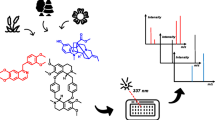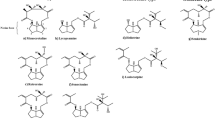Abstract
In this work, 53 selected pesticides of different chemical groups were extracted from Chinese herbal medicines and determined by ultra-high-performance liquid chromatography (UHPLC)–tandem mass spectrometry (MS/MS) using both electrospray ionization (ESI) and atmospheric-pressure chemical ionization (APCI). Extracts were obtained using the acetonitrile-based quick, easy, cheap, effective, rugged, and safe (QuEChERS) sample preparation technique. Cleanup was performed by dispersive solid-phase extraction using primary secondary amine, graphitized carbon black, and octadecylsilane. Two atmospheric-pressure interfaces, ESI and APCI, were checked and compared. The validation study, including detection limits, linearity, and matrix effects, was conducted on fritillaria, radix ginseng, folium isatidis, semen persicae, and flos lonicerae in multiple reaction monitoring mode. These matrices represent a variety of plants used in traditional Chinese medicine. Fritillaria and radix ginseng were chosen as representatives for roots, folium isatidis was chosen as a representative for leaves, semen persicae was chosen as a representative for seeds, and flos lonicerae was chosen as a representative for flowers. The limits of detection for pesticides were lower in the UHPLC–ESI-MS/MS method than in the UHPLC–APCI-MS/MS method. Matrix effects on the two ionizations were evaluated for the five matrices. Soft signal enhancement in UHPLC–APCI-MS/MS and signal suppression in UHPLC–ESI-MS/MS were observed.

Overview of UPLC–MS/MS assay for comparing the APCI and ESI interfaces



Similar content being viewed by others
References
Xie MY, Wan YQ (2003) Determination of organophosphorous pesticide residues in traditional chinese medicines by capillary gas chromatography. J Nanchang Univ (Nat Sci) 7(4):338–340
Yanez KP, Bernal JL, Nozal MJ, Martín MT, Bernal J (2013) Determination of seven neonicotinoid insecticides in beeswax by liquid chromatography coupled to electrospray-mass spectrometry using a fused-core column. J Chromatogr A 1285:110–117
Hollosi L, Mittendorf K, Senyuva HZ (2012) Coupled turbulent flow chromatography: LC-MS/MS method for the analysis of pesticide residues in grapes, baby food and wheat flour matrices. Chromatographia 75(23–24):1377–1393
Kmellára B, Fodora P, Parejab L, Ferrer C, Martínez-Uroz MA, Valverde A, Fernandez-Alba AR (2008) Validation and uncertainty study of a comprehensive list of 160 pesticide residues in multi-class vegetables by liquid chromatography–tandem mass spectrometry. J Chromatogr A 1215:37–50
Mostafa A, Medley G, Roberts DM, Mohamed MS, Elshanawani AA, Roberts MS, Liu X (2011) Simultaneous quantification of carbamate insecticides in human plasma by liquid chromatography/tandem mass spectrometry. J Chromatography B 879(23):2234–2238
Garrido Frenich A, Martínez Vidal JL, Pastor-Montoro E, Romero-González R (2008) High-throughput determination of pesticide residues in food commodities by use of ultra-performance liquid chromatography–tandem mass spectrometry. Anal Bioanal Chem 390:947–959
Kinsella B, Lehotay SJ, Mastovskab K, Lightfield AR, Furey A, Danaher M (2009) New method for the analysis of flukicide and other anthelmintic residues in bovine milk and liver using liquid chromatography–tandem mass spectrometry. Anal Chim Acta 637:196–207
Romero-González R, Garrido Frenich A, Martínez Vidal JL (2008) Multiresidue method for fast determination of pesticides in fruit juices by ultra-high performance liquid chromatography coupled to tandem mass spectrometry. Talanta 76:211–225
Picó Y, Font G, Ruiz MJ, Fernández M (2006) Control of pesticide residues by liquid chromatography-mass spectrometry to ensure food safety. Mass Spectrom Rev 25:917–960
Picó Y, Blasco C, Font G (2004) Environmental and food applications of LC-tandem mass spectrometry in pesticide-residue analysis: an overview. Mass Spectrom Rev 23:45–85
Soler C, Mānes J, Picó Y (2008) The role of the liquid chromatography-mass spectrometry in pesticide residue determination in food. Crit Rev Anal Chem 38:93–117
Kuster M, Alda ML, Barcelo D (2006) Analysis of pesticides in water by liquid chromatography- tandem mass spectrometric techniques. Mass Spectrom Rev 25:900–916
Wu YB, Liu XA, Dong FS, Xu J, Yan ZM, Wu XH, Zheng YQ (2013) Simultaneous determination of thiodicarb and its main metabolite residues in cotton by ultra-performance liquid chromatography coupled to tandem mass spectrometry. Anal Methods 5(4):1052–1057
Zhao HX, Zhao SC, Deng LG, Mao JS, Guo CY, Yang GS, Lu X, Aboul-Enein HY (2013) Rapid determination of organonitrogen, organophosphorus and carbamate pesticides in tea by ultrahigh-performance liquid chromatography-tandem mass spectrometry. Food Anal Methods 6(2):497–505
Yang RZ, Wang JH, Wang ML, Liu WH (2011) Dispersive solid-phase extraction cleanup combined with accelerated solvent extraction for the determination of carbamate pesticide residues in radix glycyrrhizae samples by UPLC-MS-MS. J Chromatogr Sci 49(9):702–708
Thurman EM, Ferrer I, Barceló D (2001) Choosing between atomspheric pressure chemical ionization and electrospray ionization interfaces for the HPLC/MS analysis of pesticides. Anal Chem 73(22):5441–5449
Titato GM, Bicudo RC, Lancas FM (2007) Optimization of the ESI and APCI experimental variables for the LC/MS determination of s-triazines, methylcarbamates, organophosphorous, benzimidazoles, carboxamide and phenylurea compounds in orange samples. J Mass Spectrom 42:1348–1357
Marín JM, Pozo ÓJ, Sancho JV, Pitarch E, López FJ, Hernández F (2006) Study of different atmospheric-pressure interfaces for LC-MS/MS determination of acrylamide in water at sub-ppb levels. J Mass Spectrom 41:1041–1048
Picó Y, Font G, Moltó JC, Mañes J (2000) Pesticide residue determination in fruit and vegetables by liquid chromatography-mass spectrometry. J Chromatogr A 882:153–173
Careri M, Bianchi F, Corradini C (2002) Recent advances in the application of mass spectrometry in food-related analysis. J Chromatogr A 970:3–64
Blasco C, Font G, Picó Y (2004) Multiple-stage mass spectrometric analysis of six pesticides in oranges by liquid chromatography-atmospheric pressure chemical ionization-ion trap mass spectrometry. J Chromatogr A 1043:231–238
Ferrer C, Lozano A, Agüera A, Jiménez Girón A, Fernández-Alba AR (2011) Overcoming matrix effects using the dilution approach in multiresidue methods for fruits and vegetables. J Chromatogr A 1218:7634–7639
Sangster T, Spence M, Sinclair P, Payne R, Smith C (2004) Unexpected observation of ion suppression in a liquid chromatography/atmospheric pressure chemical ionization mass spectrometric bioanalytical method. Rapid Commun Mass Spectrom 18:1361–1364
Cunha SC, Fernandes JO (2011) Multipesticide residue analysis in maize combining acetonitrile-based extraction with dispersive liquid–liquid microextraction followed by gas chromatography–mass spectrometry. J Chromatogr A 1218:7748–7757
Matuszewski BK (2006) Standard line slopes as a measure of a relative matrix effect in quantitative HPLC-MS bioanalysis. J Chromatogr B Anal Technol Biomed Life Sci 830(2):293–300
Souverain S, Rudaz S, Veuthey JL (2004) Matrix effect in LC-ESI MS and LC-APCI-MS with off-line and on-line extraction procedures. J Chromatogr A 1058(1–2):61–66
Acknowledgments
The authors are grateful to the Innovation Method Fund of China (no. 2010IM030400) for the financial support that made this research possible. Lu Xu is gratefully acknowledged for providing language help with the writing.
Author information
Authors and Affiliations
Corresponding author
Rights and permissions
About this article
Cite this article
Chen, L., Song, F., Liu, Z. et al. Study of the ESI and APCI interfaces for the UPLC–MS/MS analysis of pesticides in traditional Chinese herbal medicine. Anal Bioanal Chem 406, 1481–1491 (2014). https://doi.org/10.1007/s00216-013-7508-7
Received:
Revised:
Accepted:
Published:
Issue Date:
DOI: https://doi.org/10.1007/s00216-013-7508-7




